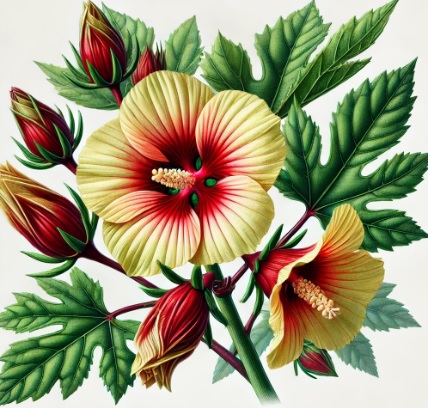Roselle (Hibiscus sabdariffa), commonly known as Roselle or Jamaican Sorrel, is a tropical plant renowned for its edible calyces and vibrant red flowers. Native to Africa and widely cultivated in tropical and subtropical regions, this plant is valued for its culinary and medicinal uses as well as its ornamental appeal.
Botanical Classification:
Family: Malvaceae
Genus: Hibiscus
Species: H. sabdariffa
Common Names: Roselle, Jamaican Sorrel, Red Sorrel
Plant Characteristics:
Size: Hibiscus sabdariffa grows to a height of 1 to 2.5 meters (3 to 8 feet), with a similar spread.
Leaves: The leaves are lobed, typically dark green with a slightly serrated margin. They have a smooth texture and are arranged alternately along the stems.
Flowers: The plant produces striking flowers that are usually yellow or pale pink with a red center. Each flower blooms for a short period but is replaced by new blooms regularly.
Calyces: The prominent feature of this plant is its red calyces (the outer part of the flower), which are fleshy and cup-shaped. These calyces are used in various culinary and medicinal applications.
Chemical Composition and Structure:
The plant contains several valuable compounds:
Flavonoids: Such as quercetin and anthocyanins, known for their antioxidant and anti-inflammatory properties.
Organic Acids: Including citric acid and malic acid, which contribute to the plant’s tart flavor and potential health benefits.
Vitamin C: Found in high concentrations in the calyces, providing significant antioxidant and immune-supporting properties.
Polysaccharides: Present in the mucilage, offering hydrating and soothing effects.
Uses and Benefits:
Culinary: The calyces of Hibiscus sabdariffa are used to make beverages, jams, and sauces. In many cultures, the plant is used to prepare drinks such as hibiscus tea, which is known for its tart flavor and deep red color.
Medicinal: In traditional medicine, the plant is used for its potential benefits in managing hypertension, supporting digestion, and improving skin health. Its high vitamin C content also supports immune function.
Cosmetic: Hibiscus sabdariffa extract is utilized in skincare products for its antioxidant and anti-inflammatory properties, helping to improve skin tone and texture while providing hydration.
Ornamental: The plant is grown for its attractive flowers and calyces, adding visual interest to gardens and landscapes.
Applications:
Cosmetics: Incorporated into lotions, creams, and serums for its skin-soothing and antioxidant benefits.
Food and Beverages: Used in teas, juices, jams, and sauces for its tart flavor and vibrant color. Karcadè is a drink made from the flowers of the Hibiscus sabdariffa.
Traditional Medicine: Employed in herbal remedies and supplements for its potential health benefits, including blood pressure management and digestive support.
Environmental and Safety Considerations:
Environmental Impact: Hibiscus sabdariffa is well-suited to tropical and subtropical climates and can help improve soil health by providing organic matter. It is relatively low-maintenance and can be grown in various soil types.
Safety: Generally considered safe for consumption and topical use. However, individuals with allergies to plants in the Malvaceae family should exercise caution.
INCI:
Skin conditioning agent. It is the mainstay of topical skin treatment as it has the function of restoring, increasing or improving skin tolerance to external factors, including melanocyte tolerance. The most important function of the conditioning agent is to prevent skin dehydration, but the subject is rather complex and involves emollients and humectants that can be added in the formulation.
Synonyms:
CAS:
![]() Roselle
Roselle 

